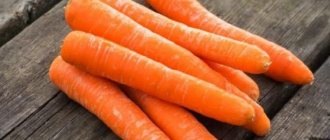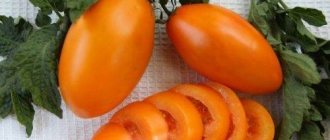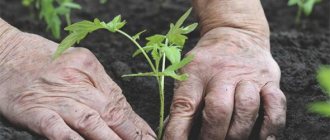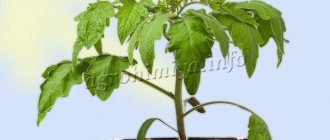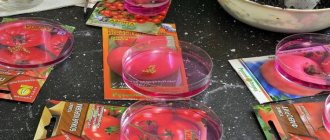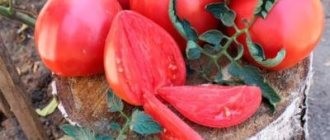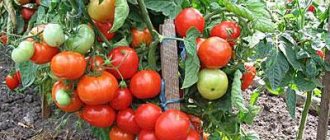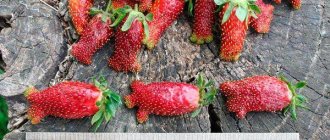The Russian Yablonka tomato is the most favorite variety for summer residents who do not have the opportunity to frequently visit the garden. Tomatoes of the Yablonka Russian variety are very picky about climatic conditions and do not require constant care. The plant is very resistant to pests and diseases; the bush does not need to be shaped or pinched. The yield of Yabloko Russia tomato is high - no more than 100 tomatoes. The fruits will look beautiful in jars when sealed, as they are small in size and round in shape.
Description of the tomato variety Yablonka Russia
Apple tree of Russia is a determinate, medium-branched variety, which is why it does not require pinching. The foliage of the bushes is average.
Plant height varies from 80 to 100 cm in open ground. When growing tomatoes in a greenhouse, this figure is slightly higher - 110-125 cm. The shoots of the species are quite powerful, the leaf plate is potato-type. The first inflorescence is located above 7–9 leaves.
Fruiting of Yablonka Russia tomatoes is extended over time, however, the ripening of the fruit is relatively smooth. Despite the fact that the culture is heat-loving, it can withstand temperature changes well.
When tomatoes enter the active growth phase, they must be tied up
Description of fruits
The average weight of Yablonka Russia tomatoes is 100 g. The pulp of the ripened fruits is juicy and fleshy. If you cut into a tomato, you can see that the fruit consists of two chambers with a large number of seeds.
As you can see in the photo below, tomatoes of the Yablonka Russia variety have a spherical shape without ribbing. The color of the skin when fully ripe is bright red.
The taste of this type can be described as harmonious - it is not cloyingly sweet, however, there is also no strong sourness. Only slightly unripe fruits are slightly sour.
The tomatoes are medium in size, which is convenient for rolling into jars for the winter.
Planting seedlings
The Yablonka tomato in Russia should be grown only through seedlings. Moreover, if the seedlings grown at home are healthy and strong, then this will be the key to a future high harvest.
Tomato seedlings
Seed material should be planted in the second ten days of March, so that after 55-60 days the grown seedlings can be transplanted to a permanent place.
Nutrient substrate is usually purchased at a gardening store, but many vegetable growers prefer to prepare a nutritious soil mixture themselves. To do this, they have been stocking the following components since the fall:
- turf;
- high peat;
- humus or compost;
- river sand.
These ingredients are mixed in a ratio of 1:2:1:0.5. You should also add 1 tbsp to this mixture. l. superphosphate, st. l. potassium salt, 10 g urea.
To make the soil mixture looser, it is recommended to add vermiculite or sawdust.
Approximately 10-12 days before planting the seed, the soil mixture prepared at home must be disinfected. To do this, you can pour it with a weak solution of potassium permanganate or keep the substrate in an oven preheated to 180 degrees for 15-20 minutes.
Related article:
Tomato Absinthe - description and characteristics of the variety with green fruits
Then the soil mixture needs to be spread out into containers, watered and seed material spread over its surface. It is covered with a 1 cm thick substrate on top, covered with polyethylene and placed in a warm room, the temperature in which should be about 25 degrees Celsius.
After the sprouts appear, it is necessary to remove the polyethylene and move the containers to a bright place, preferably on a windowsill facing south.
Growing seedlings are periodically watered (as the top layer of the substrate dries) with warm, settled water. After the plants have several permanent leaves, they should be picked into separate containers.
This is interesting: How to pick tomatoes correctly and when
During the growing period, seedlings are fed a couple of times with liquid fertilizer intended for vegetable plants.
Related article:
What mistakes lead to a decrease in tomato yield?
Characteristics of the tomato Yablonka Russia
Tomatoes bear fruit best in regions with a mild climate and when grown in a greenhouse, however, Yablonka of Russia is also suitable for planting in northern latitudes. Despite the fact that this variety is very unpretentious, the bushes respond well to timely fertilizing, responding with especially abundant fruiting.
Advice! It is best to plant tomatoes where pumpkins, carrots, beets or legumes previously grew. Eggplants and potatoes are bad predecessors.
Tomato yield Yablonka Russia and fruiting
The Russian apple tree is an early-ripening variety that fully ripens in 110-125 days. At the same time, the plants form a fairly large number of ovaries - from each bush, with good care, you can remove about 80-100 fruits (5-8 kg of harvest) in open ground.
Advice! Planting in fertile loamy soil helps increase productivity. You should also give preference to open and illuminated areas. You should not plant tomatoes in the shade.
The advantage of Yablonka Russia tomatoes is the fact that they ripen well indoors - the fruits can be harvested while still green if unexpected frosts suddenly occur.
Area of application of fruits
In the State Register of Russia, the variety is listed as a salad variety and is recommended for fresh consumption, however, the scope of application is not limited to this. The Russian apple tree produces fruits of approximately the same size, round and even - these are the qualities that allow tomatoes to be used for whole-fruit canning. In addition, the variety is suitable for making juices, purees and a variety of sauces.
Resistance to diseases and pests
Yablonka tomatoes of Russia are resistant to almost all fungal diseases of the Solanaceae family, so the bushes rarely get sick. On the other hand, this variety also has a serious vulnerability - tomatoes are not resistant to late blight. If the disease affects the plantings, the likelihood of successful treatment is extremely low. If the infection has spread extensively, it is easier to dig up the bush and burn it. Tomatoes infected with anthracnose also rarely recover.
The Yablonka Rossii variety does not attract insects. If pests are noticed on the leaves of tomatoes, the plantings can be treated with any insecticide from the agricultural store.
Harvesting and application
Depending on the manufacturer of Yablonka Russia tomato seeds, the packaging indicates a different period of fruit ripening - from 90 to 120 days. Gardeners note that the maximum ripening period is 125 days.
Due to their good taste, rich aroma and small size, tomatoes are used both fresh and for canning. They are also processed into juice and paste. The ideal combination of taste with all types of vegetable oils allows them to be used for preparing various dishes.
The resistance to cracking and density of tomatoes contribute to their long-term storage and preservation of their presentation during transportation. It is recommended to store Yablonka Rossii tomatoes in a cool place (refrigerator or basement).
Pros and cons of the variety
pros
- low maintenance requirements;
- resistance to prolonged drought;
- harmonious taste without strong sourness;
- immunity to most diseases of the Solanaceae family;
- versatility of fruit use;
- resistance to sudden temperature changes;
- good transportability;
- the skin of ripened fruits is not prone to cracking;
- high yields with good care - from 60 to 100 tomatoes can be harvested from one bush;
- fruiting is extended over time, which allows you to harvest fresh crops from the beds until mid-late September.
Minuses
- many gardeners complain about poor seed germination;
- often affected by late blight.
Tomatoes ripen quite evenly and are almost identical in shape
Advantageous characteristics of the variety
Compared to other species, the Russian apple tree has practically no disadvantages, so you can immediately focus on the advantages of tomatoes:
- They are not picky about the external environment and can be grown both in greenhouses and in the open.
- Requires minimal maintenance.
- High yield.
- Excellent taste characteristics.
- Do not deteriorate during transportation.
- They are a suitable specimen for beginning gardeners.
Growing rules
Yablonka Rossii is a heat-loving tomato variety that is grown through seedlings. Seeds are sown in early March. It is better to use a little more seeds than required - some of them may not germinate.
When the first shoots form 2-3 true leaves, the seedlings are transplanted into separate containers. In the Northern regions, it is recommended to start hardening off the seedlings 1-2 weeks before planting - this will make it easier for the plants to get used to the new temperature regime. To do this, in April, the container with seedlings is placed outside (for 1-2 hours).
Transplantation into open ground
Yablonka Rossii tomatoes are transplanted into open ground at the end of May, when the threat of night frosts has passed. In the northern regions of the country, the timing of transplantation is shifted to the first days of June. The age of the seedlings should be approximately two months.
The recommended planting pattern is 70 x 70 cm. The area for tomatoes is prepared in advance - the soil is moderately dug up and organic fertilizers are added to the soil. You can use rotted manure, stale grass, or a complex composition as primary fertilizing. Additionally, a small amount of fertilizer is placed directly into the hole before planting the seedling, however, before that, the fertilizer is sprinkled with earth. If this is not done, the tomato root system may get seriously burned.
Complete the transplantation procedure with abundant watering.
Advice! It is recommended to cover the seedlings with film for the first 5-8 days - this way the tomatoes will quickly get used to the new place.
Aftercare
Water the beds moderately, taking into account weather conditions - the soil should not dry out or crack, however, waterlogging is also detrimental to tomatoes. To reduce the number of waterings, the beds should be sprinkled with mulch: humus, sawdust or straw. This material perfectly retains moisture in the soil.
The Yablonka Rossii variety is fertilized several times per season. The first feeding is carried out two weeks after planting in open ground. For this you can use a solution of mullein or nettle infusion (0.5 liters diluted in 10 liters of water).
Important! Fertilizers are applied at the root so that the liquid does not get on the leaves of the tomatoes.
A small amount of wood ash is added to the soil every two weeks.
History of variety development
This tomato variety was bred at the end of the last century by a group of Russian breeders, headed by the president of the Russian Ogorod V. Korochkin and a specialist from the All-Russian Research Institute of Selection and Seed Production of Vegetable Crops V. Vasilevsky.
Related article:
Tomato Sis F1 - description and characteristics of a mid-season variety from SeDeK
Tomato seeds Yablonka Russia
The Yablonka tomato of Russia was sent for variety testing in 1998, which was carried out by the State Committee for Testing and Protection of Breeding Achievements. The tomato was included in the Russian State Register a couple of years later; the variety was recommended for cultivation in most Russian regions in garden beds and in greenhouse conditions.
Pest and disease control
The greatest threat to plantings is late blight. It is almost impossible to cure infected tomatoes, so special attention should be paid to preventive treatments of the bushes - from time to time they are sprayed with Epin. Such prevention is especially important during periods of prolonged rain, when increased soil and air humidity in combination with low temperatures can provoke an outbreak of the disease.
Advice! When growing tomatoes in a greenhouse, it is recommended to periodically ventilate the beds to reduce the risk of late blight infection.
Agrotechnical preventive measures include loosening the rows and observing watering standards - plantings should not be flooded so that moisture does not stagnate in the soil. For pests use any general industrial insecticides. You can take the drug "Tanrek" for these purposes.
Farmers' opinions
Roman: “I never tire of repeating that Yablonka is my favorite tomato variety. I've been growing this for four years. There is little time for care, so the plants mostly grow on their own. We have never been sick with anything. The harvest is excellent."
Olesya: “Tomatoes are very tasty. They are unpretentious in care. But last year we were among the first to become infected with late blight. We lost 4 bushes out of 15. The rest were saved. About 5 kg were collected from the bush. This year they planted it again.”
Vitaly: “I plant Apple tomatoes exclusively for pickling. My wife wraps them whole in jars. This is how we provide for ourselves and sell them. The harvest is rich. They’re not bad when fresh, but I prefer the Ox’s Heart. We always make fresh salads from it.”

